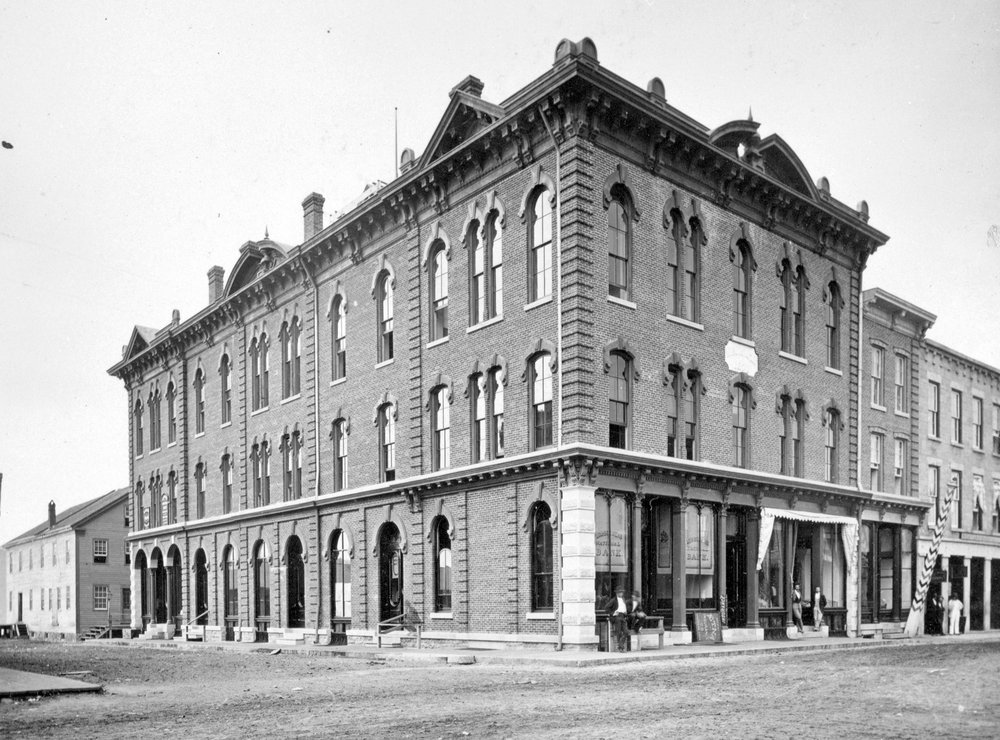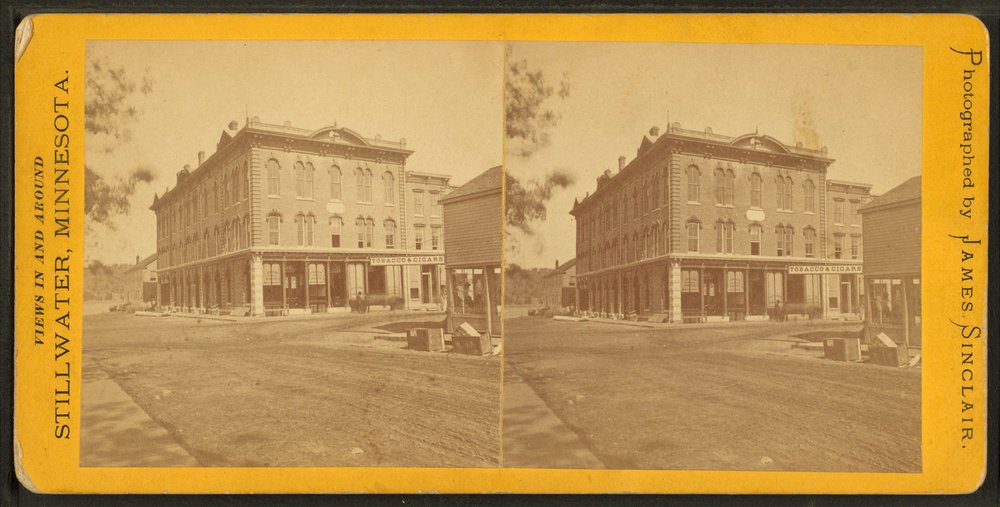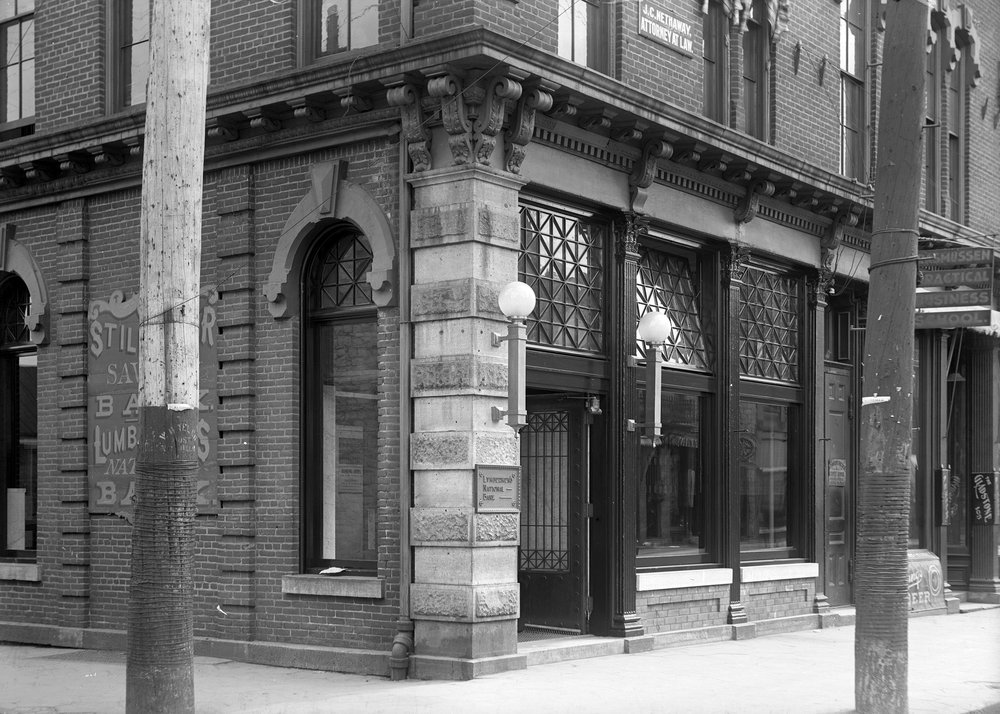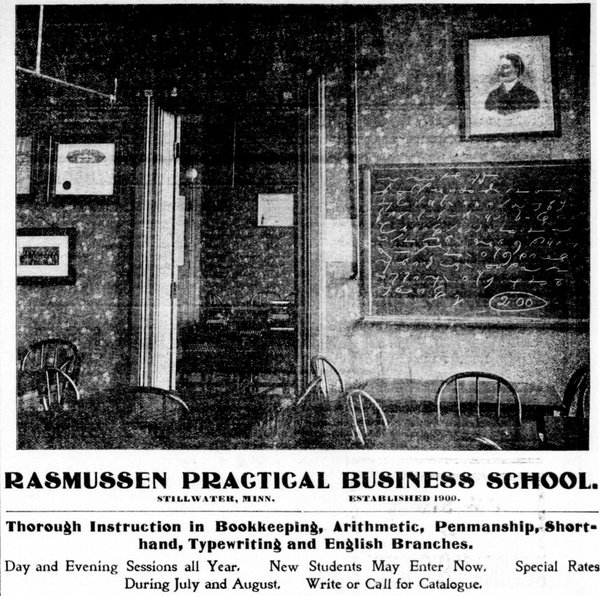Hersey & Staples Block
When it opened in 1872, the Hersey & Staples Block combined the headquarters of a leading Stillwater lumber firm with a variety of shopping, professional, and entertainment establishments.
Hersey, Staples & Co.
Of the approximately 50 sawmills operating on the St. Croix River in its early lumbering era, perhaps the best-known was Hersey, Staples & Company, located on the south end of Stillwater. It wasn’t the earliest mill, but it introduced significant technological innovations to St. Croix lumbering, including steam power and the use of machinery for all aspects of the milling process. In 1855, the Hersey-Staples mill could produce 125,000 feet of finished lumber every 24 hours. The company established a prominent role in Stillwater life that would continue for decades.[1]
As Stillwater grew, Hersey, Staples & Co. expanded beyond lumbering. In 1871, it obtained federal approval to establish the Lumberman’s National Bank, and soon started construction of a large new headquarters, bank, and commercial building at Main and Myrtle streets.[2]
The Hersey-Staples block represented a wave of more elaborate brick and stone buildings that replaced Stillwater’s original wooden downtown as the city prospered. Partner Isaac Staples told the Stillwater Messenger that he planned to make the building “one of the best and most handsome in the State.” The Messenger’s editor reviewed the plans and wrote that “with the dark colored Superior stone for corners and trimmings, we know of no business block in the State that promises so handsome an exterior. It will be a credit to the city as well as to the business enterprise and sagacity of Mr. Staples.”[3]
The building’s plans took advantage of its prominent location, with eight entrances from three streets. It was to be three stories above ground plus a finished basement. A central stairway, accessed from Main Street, would provide access to the upper floors. The exterior was to be built of Stillwater stone, with trimmings of Lake Superior stone.[4]
The building took approximately nine months to construct. One of the final, and perhaps most challenging, tasks was to install the safe for the Lumberman’s National Bank:
A large force of muscular fellows, under charge of Mr. Willim, struggled courageously for several hours last Saturday, hosting a big safe into position for the Lumberman’s National Bank, in the new Hersey & Staples’ block corner of Main and Myrtle streets. The safe is very large and commodious, weighing 4444 pounds. It has what is known as the Magnetic Lock, with numberless changes, and is considered absolutely burglar-proof. The capacious stone vault in which it is located is completely fire-proof.[5]
Writing about the finished building, Stillwater Gazette editor Augustus B. Easton praised the structure’s “beautiful and commanding appearance…. The work throughout, from the foundation walls to the roof, is of the most thorough, complete, and substantial character.” Easton praised numerous design features, such as the “heavy, tasteful and elaborate” galvanized iron cornices and distinctive window designs.[6]
Within months of its opening, the building contained an impressive variety of retail, banking, business, and entertainment establishments.
Retail
Much of the ground floor was devoted to the Hersey, Doe & Staples store, offering more than a dozen departments ranging from dress goods and home furnishings, to hardware for builders, ropes for river pilots, and flannel attire for lumberjacks. An advertisement boasted: “Our new store is so arranged that we can display goods to our customers with much less trouble and greater satisfaction than is experienced by any other general stock store in the State.” At the rear of the store was the grocery department, offering “everything to make a first class choice family grocery department complete.” Upstairs, the store offered a carpeting department.[7]
The Stillwater Messenger offered its readers a tour of the new store:
The goods are arranged in various classes, and the departments kept separate from each other by an admirable arrangement that prevents confusion, and adds greatly to the attractiveness of the store.
Commencing at the front on the south side, the departments come in order as follows:
Yankee Notions, Hosiery, trimmings, &c.
Dress Goods.
Hats and Caps.
Gentlemen’s furnishing goods.
Commencing on the north side, and going from front to rear, the following is the arrangements:
Domestic Goods.
Ladies boots and shoes, classified by sizes, in neat boxes, and also in drawers under the counter.
Hardware.
In the centre of the store, near the rear end, is a broad counter with drawers beneath, that pull out from either side, filled with an immense stock of men’s and boys’ boots and shoes.[8]
The Messenger also described the grocery department, which formed the back of the store but also had its own entrance facing Myrtle Street:
On the east side neatly arranged shelves and drawers contain a large and fine assortment of canned fruits, coffees, teas in large air tight boxes, made for this purpose, to preserve the flavor, and groceries of all kinds. Neat sugar boxes are beneath the shelving and under the counter, cracker barrels on little cars can be rolled out in a moment and shoved back so as to [be] out of the way.
On the west side is the crockery department with shelves, cupboards and drawers all arranged with an eye to convenience as well as attractiveness.[9]
Banking and Professional Offices
The Lumberman’s National Bank was also located on the first floor, at the corner of Main and Myrtle. The Gazette’s Easton was particularly drawn to one feature: “The counter is one of the most beautiful in the Northwest, being composed of walnut and maple, with base of oak, surmounted by what is known as a silver rail, which is highly ornamental, with plate glass panels, one-fourth of an inch in thickness, of remarkable purity…. The most remarkable thing about the counter is the fact that no varnish was used in its finish, the brilliant appearance being entirely owing to the delicate and elaborate manner in which it is polished.” The new bank’s manager was Henry Cannon, who later became United States Comptroller of the Currency and was eventually president and chairman of Chase National Bank in New York.[10]
In addition to the retail and banking spaces, the first floor housed the offices of the Hersey-Staples company itself. Much of the second floor was rented out as professional offices. Among the well-known attorneys who moved into the new building were J.N. Castle and Fayette Marsh, whose large offices were “well lighted and furnished”, with a rapidly growing law library that the Stillwater Messenger believed was “one of the very best in the state.”[11]
Another prominent tenant was the office of the Surveyor General of Logs and Lumber, an important agency that accounted for hundreds of millions of feet of logs passing through the St. Croix Boom each year, as well as the complex system of more than 3,000 branding marks used to identify the logs’ owners.[12]
“Mammoth” Music Hall
The third floor was an event hall for concerts, dances, lectures, and similar public events. It featured a 25x47 foot stage, two dressing rooms, and a ticket office. The hall was still under construction as the rest of the building approached completion, and the first event there appears to have been a July 2-9, 1872 fair to raise funds for the construction of the large new Church of St. Michael on the South Hill. Ads for the event called the Hersey-Staples space “Mammoth Hall.”[13]
The fair was to run for a full week, and the Gazette wrote about its first two nights:
Over five hundred people were present on Monday evening, and over seven hundred on Tuesday evening.
The hall is gorgeously decorated with flags and evergreens, and presents a beautiful and tasteful appearance.
Among the attractive features—to say nothing of the charming lady attendants in the various departments, flitting like fairies to and fro about the room—are presented all the luxuries of this or any other clime, obtainable at any price—ice cream, strawberries, lemonade, oysters, roast turkey, chickens, &c., &c., and an extra dish this (Wednesday) evening will be served up, consisting of roast pig, and the concomitant etceteras. The same kind will also be served up tomorrow.
In fact, no expense or pains are spared to make this the pleasantest and most successful fair of the season. We are glad to note that the efforts in this direction are cordially and responded to by our people—as the object to be secured is certainly a laudable one.[14]
In later years, when Stillwater had the Grand Opera House and other dedicated theaters, the Hersey-Staples hall became known as Music Hall and was best known for dancing. As local historian E.L. Roney wrote:
Dancing was the great winter indoor pastime in Stillwater [around 1900]. Never a week went by that two or three dances were not held and many of them were held in Music Hall. Local orchestras provided the music. Waltzes, two-steps and the good old square dance were the favorites. The schottische was popular too. Stillwater had many excellent dancers and it was a treat to watch them perform. Dancing, of course, was not permitted in the schools but high school students loved dancing and attended many of the hops at Music Hall. Around the Turn of the Century a high school group of seven boys known as the SEC (Seven Entertainers Club) sponsored two or three dances every winter at Music Hall. They were among the most popular affairs of the winter.[15]
The End of a Landmark
By 1967, the Lumberman’s National Bank had been replaced by Cosmopolitan State Bank, whose directors announced “that they intend to compliment the restoration of the downtown Stillwater area with a unique new bank building that will feature soft, artistic wooden beams and pillars that will be complimented by a warm burnished concrete exterior, on the corners of Main and Myrtle and Water streets.” Unlike the old building, the new bank would have a drive-through window. Demolition began on September 23, 1967, marking the end of what was once Stillwater’s most prominent commercial building. Historic rehabilitation projects became more common in Stillwater starting in the 1970s, but it was too late for the Hersey-Staples Block.[16]
In 1991, Cosmopolitan State Bank merged with Central Bank. Around 1997, the bank closed its Main Street location. Since then, the building has housed Stillwater Antiques.[17]
—Matt Thueson
Matt Thueson is the chair of the Stillwater Heritage Preservation Commission.
References
-
Agnes M. Larson, “When Logs and Lumber Ruled Stillwater”, Minnesota History 18, no. 2 (summer 1937): 165-179. Lucile M. Kane, “Hersey, Staples and Company 1854-1860; eastern managers and capital in frontier business”, Bulletin of the Business Historical Society 26, no. 4 (1952): 199-213.
↩ -
“Another National Bank in Stillwater”, Stillwater Messenger, January 20, 1871, p. 4.
↩ -
“Staples’ New Block”, Stillwater Messenger, June 2, 1871, p. 4.
↩ -
“Staples’ New Block”, Stillwater Messenger, June 2, 1871. “The Hersey & Staples Block”, Stillwater Gazette, March 19, 1872, p. 4.
↩ -
“A Splendid Safe”, Stillwater Gazette, February 20, 1872, p. 4.
↩ -
“The Hersey & Staples Block”, Stillwater Gazette, March 19, 1872.
↩ -
Grocery department ad, Stillwater Gazette, May 14, 1872, p. 1. “Removed to New Store” ad, Stillwater Messenger, June 28, 1872, p. 3.
↩ -
“A Splendid Establishment”, Stillwater Messenger, April 27, 1872, p. 1.
↩ -
Ibid.
↩ -
“The Hersey & Staples Block”, Stillwater Gazette, March 19, 1872. Edgar L. Roney, “Music Hall Memories”, Stillwater Evening Gazette, September 28, 1967, p. 4.
↩ -
“Fine Office Rooms”, Stillwater Messenger, May 24, 1872, p. 4.
↩ -
“The New Surveyor-General’s Office”, Stillwater Gazette, May 28, 1872, p. 4.
↩ -
“The Hersey & Staples Block”, Stillwater Gazette, March 19, 1872. “Grand Fair for the New Catholic Church”, Stillwater Messenger, June 28, 1872, p. 4.
↩ -
“The Catholic Fair”, Stillwater Gazette, July 2, 1872, p. 4.
↩ -
Roney, “Music Hall”, Stillwater Evening Gazette, September 28, 1967.
↩ -
Vince Hamann, “Cosmopolitan Bank Unveils Plans For New Bank By ’68”, Stillwater Evening Gazette, September 23, 1967, p. 1.
↩ -
"Bank plan OK", Saint Paul Pioneer Press, April 26, 1991. 1996 and 1997 Stillwater City Directories.
↩




